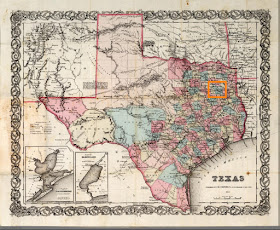Mary Warren was born in Virginia in 1810 according to her 1870 and 1880 U.S. Census records. From Jeremiah Warren's probate records we know she and three children were living in Hancock County, Georgia, so Mary would have been about 22.
There is no way to be certain of the date Mary found herself as part of Jeremiah's human property, looking at the census records it could have been by 1830 or even as early as 1820.*

[1820 & 1830 U.S. Census from Ancestry.com]
After Mary was mentioned twice early in Jeremiah's probate records she disappears from direct sight until we find her living near one of Jeremiah's executors, John Graybill, in Smith County, Texas, in the 1870 census.
The simplest explanation for that fact is that Graybill probably transferred Mary to his property sometime after 1837; he was still identified as Jeremiah's executor in Georgia's property tax digest lists for 1840 but only one enslaved person was included in the estate.**
[Detail of Militia District Number: 101; Year : 1840. Ancestry.com. Georgia, Property Tax Digests, 1793-1892 [database on-line]. Provo, UT, USA: Ancestry.com Operations, Inc., 2011. Original data: Georgia Tax Digests [1890]. 140 volumes. Morrow, Georgia: Georgia Archives.]
If that's true Mary (who would have been 30 that year) could be one of two women listed in the 1840 U.S. Census.
Ten years later Mary is probably one of three enslaved women listed in the 1850 Slave Schedule for Hancock County, Georgia, most likely on lines 30 or 31.
[Township : District 101. Ancestry.com. 1850 U.S. Federal Census - Slave Schedules [database on-line]. Provo, UT, USA: Ancestry.com Operations Inc, 2004. Original data: United States of America, Bureau of the Census. Seventh Census of the United States, 1850. Washington, D.C.: National Archives and Records Administration, 1850. M432, 1,009 rolls.]
[Detail from aove]
Sometime between 1850 and the 1860 U.S. Census John Graybill moved his household to
Rusk County, Texas,*** and here it's harder to locate Mary so I'm going to offer several possibilities.
[Township : Beat 8. Ancestry.com. 1860 U.S. Federal Census - Slave Schedules [database on-line]. Provo, UT, USA: Ancestry.com Operations Inc, 2010. Original data: United States of America, Bureau of the Census. Eighth Census of the United States, 1860. Washington, D.C.: National Archives and Records Administration, 1860. M653, 1,438 rolls.]
I think the two 52-year-old women listed on lines 13 and 14 are too old to refer to Mary, however the two 51-year-old women on lines 4 and 8 are possibilities once we look at the Graybill household in 1860.
[Year: 1860; Census Place: Beat 8, Rusk, Texas; Roll: M653_1304; Page: 276; Family History Library Film: 805304. Ancestry.com. 1860 United States Federal Census [database on-line]. Provo, UT, USA: Ancestry.com Operations, Inc., 2009. Images reproduced by FamilySearch. Original data: 1860 U.S. census, population schedule. NARA microfilm publication M653, 1,438 rolls. Washington, D.C.: National Archives and Records Administration, n.d.]
I believe Camillus Graybill (1832-1899) is the badly scribbled slave owner listed on line 4--he was John Graybill's third son; Graybill's sister Elizabeth A. (the widow of Henry Saunders Jernigan) is obviously the person referred to on line 8. Neither of these people appear to have owned slaves in the previous censuses; I think it's quite possible that their human property came from John Graybill.
By the 1870 U.S. Census**** both John Graybill and Mary Warren were living very near each other in Smith County, just to the west of Rusk County. But does this proximity mean that there was any connection between them?
After John Graybill died in 1875 the inventory of his estate included a list of money he was owed and two of Mary's children are named: Daniel Warren (who had already paid $25 of his $63.36 debt, leaving a balance owed of $28.36) and Keziah Warren who owed "1 account" of $16.00.
[Texas, Probate Court (Smith County); Probate Place: Smith, Texas. Ancestry.com. Texas, Wills and Probate Records, 1833-1974 [database on-line]. Provo, UT, USA: Ancestry.com Operations, Inc., 2015. Original data: Texas County, District and Probate Courts.]
Next time I'll focus on Mary Warren's children to see what we can find out about them in the various records available to us.
*An estimated 30% of slave children were separated from their families before they were ten. You can read more about what life was life for children born into slavery
here and
here.
**If there was only one enslaved person still remaining on the property Jeremiah had set aside for the benefit of Mary and the rest of the people he hoped could be legally freed one day, it seems likely it would have been either Coleman or John left as a caretaker.
***I had hope to learn when Graybill moved to the state through the Texas Voter Registration Lists, 1867-1869 but his name isn't there, although his son C. Graybill is. But the Smith County records are particularly unhelpful since the entries state that
everyone on the list had been in the state for 12 months and in the county for 6 months.
****I covered this census in last week's post
here.
© 2017 Copyright, Christine Manczuk, All Rights Reserved.












































